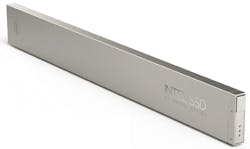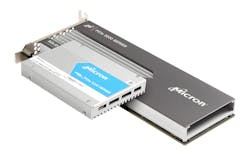I am off to host my two sessions at the Flash Memory Summit (FMS) but here are a few items of note from the conference including a new form factor from Intel for flash storage. Flash memory does not have the mechanical limitations that rotating magnetic media requires. This has dictated the form factors from 5.25-in. down to 2.5-in. hard disks and solid-state drives (SSDs) have followed suit. Intel’s Ruler form factor discards this legacy form factor for a longer layout that is amenable to rack-mount systems.
Intel’s proposed ruler form factor is designed to take advantage of flash memory’s flexibility in form-factor design.
Intel plans on delivering Optane and NAND flash memory devices using this new form factor. High-density drives like these will allow 1 Pbyte of storage to fit into a 1U slot. The form factor should also help reduce power and cooling requirements. Details are still sketchy so this form factor may have unique connectors or take advantage of those used by the U.2 form factor that supports single- and dual-port PCI Express/NVMe interfaces.
Intel is also showing off its dual-port Optane SSD drives and the DC D450x and DC D4600 series NAND flash memory drives. The 3D NAND flash drives use Intel’s new SATA controller. The drives target hard disk replacement. They have improved energy efficiency and better reliability proving 200x performance compared to hard disk drives. These high-endurance drives are available in 7-mm-high, 2.5-in. form factors.
Liteon will be talking about its use of machine learning techniques in the new flash drives. “We are in the early stages of exploring machine learning’s benefits for memory, but all signs point to us using this technology to design all of our SSDs going forward,” says Frankie Fu, director of NVM Central Lab at Lite-On Storage Group. “Our EP3 series and upcoming EPX NVMe M.2-based drives will be our first to feature Machine Learning, Intelligent Read Retry, which is achieving 81% read retry performance compared to 9% for traditional systems.”
Micron’s 9200 Series of NVMe U.2 SSDs use 3D NAND flash to support up to 11 Tbytes of storage. Its 9200 FlexPro Flex Capacity features allow users to tune the capacity of a drive for different workloads based on required performance and endurance. The drives support sequential read transfer rates up to 4.6 Gbytes/s and they can deliver over 1 M random read IOPS. The drives support PCI Gen 3 x4 NVMe interfaces.
Micron’s 9200 Series of NVMe SSDs takes advantage of 3D NAND flash to pack in up to 11 Tbytes of storage.
The 9200 Series comes in ECO, PRO, and MAX versions. The ECO has a 15.7 Pbyte endurance rate for the 11 Tbyte drive; the PRO has a 13.7 Tbyte endurance for a 7.68 Tbyte drive; and the MAX has a 34.7 Tbyte endurance for a 6.4 Tbyte drive.
Liteon developers used machine learning techniques to determine optimal value for key parameters in error recovery. Developers are also using these techniques to help identify the most efficient recovery flow so drives will be able to recover data even sooner than they do now.
Microsemi will be showing off its NVMe2108 Controller that is designed to handle 3D NAND flash with capacities in excess of 14 Tbytes using four independent flash channels. It supports PCIe Gen3 x4 or dual-independent PCIe Gen3 x2 (active active/standby) host interface used in the U.2 interface and provides a standard enterprise NVMe host control interface. The chip supports XTS-AES-256 encryption in addition to strong LDPC Flash ECC support. The system is designed to handle power faults and abrupt shutdown without loss or corruption of data.
The NVMe2108 provides programmable support for the NVMe interface, flash interface, and system controller. The programmable flash support is designed to handle SLC, MLC, enterprise MLC, and TLC flash with Toggle and ONFI interfaces.
The NVMe2108 complements Microsemi’s existing NVMe1032. The higher-end NVMe1032 has similar features but has a PCIe Gen 3 x8 or dual PCIe Gen 2 x4 interfaces.




